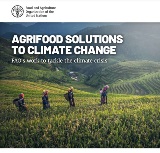Lao People's Democratic Republic
News

Transforming agrifood systems requires changing policies, mindsets, and business models
18/01/2023

CFS 41 Session – HLPE report on “Food losses and waste in the context of sustainable food systems”
30/09/2014
Articles
Events
15/ 11
2022
A brainstorming session on Food Loss and Waste (#123 Pledge) with youth and game-changing stakeholders
Sharm El-Sheikh (Egypt), Hybrid Event, 15/11/2022
Part of the activities of the Food Is Never Waste Coalition (of which FAO is a member) at COP27 in Sharm-El-Sheikh, Egypt saw the launching of a pledge to mobilize commitments...
29/ 9
2022
3rd International Day of Awareness of Food Loss and Waste
Virtual Event, 29/09/2022
On 29 September 2022, the International Day of Awareness of Food Loss and Waste will be observed for the third time.
Projects
| Title | Capacity Development to Reduce Post-harvest Losses in Horticultural Chains in Greater Mekong Sub-region Countries (FAO) |
|---|---|
| Project Code | none |
| SDG(S) |
Publications

Agrifood solutions to climate change – FAO's work to tackle the climate crisis
29/11/2023
Amid a worsening climate crisis and slow progress in cutting greenhouse gases, sustainable agrifood systems and practices can help countries and communities to adapt, build resilience and mitigate emissions. FAO is working with countries and partners at all levels to address the challenges of food security, climate change and biodiversity loss. But success in this area will ultimately require global commitment to significantly increasing the quality and quantity of climate finance.

Yams | Post-harvest operations
28/08/2003
Yams are second to cassava as the most important tropical root crop and are a staple food in many parts of Africa, Southeast Asia and the South Pacific. Seventy percent of the 50 million tonne world output of 2008 was grown in Nigeria (FAOSTAT).The starchy tuber, with a rough brown skin, is produced by a herbaceous vine and takes from 8 to 11 months to mature after planting.

Papaya: Post-Harvest Operations
04/03/2014
Papaya (Pawpaw) is an early-bearing, space-conserving, herbaceous crop requiring a tropical climate. It is fast growing and has a single straight or sometimes branched stem reaching 2-10 m height. With the development of better cultivation techniques, new varieties, improved crop handling and post-harvest technologies, papaya is gaining importance in the world tropical fruit market.
Multimedia
Food loss and waste are among the main causes of climate change
29/09/2022
Every year, around 14 percent of the world’s food is lost after harvest and in the distribution chain prior to retail, and an additional 17 percent of food available to consumers is wasted. Food loss and waste account for 8 to 10 percent of the world’s greenhouse gas emissions. Carbon dioxide i...
Achieving Better Nutrition in Asia-Pacific by reducing food loss and waste – leaving no one behind
13/06/2022
This video looks at an example of achieving better nutrition in Malaysia through reductions of food loss and waste.
IDAFLW 1st celebration - Interview with Rosa Rolle, FAO
29/09/2020
Rosa Rolle, FAO officer, highlights how food loss and waste present challenges to meeting our goals of feeding a growing population, but there are steps we can take to diminish food loss and waste.
How to tackle food loss and waste
14/10/2019
Although there may be an economic loss, food diverted to other economic uses, like animal feed, is not considered as food loss or waste, nor are the inedible parts of food products.
